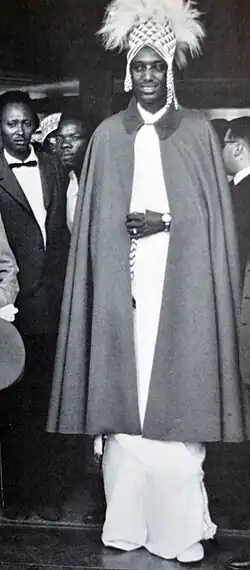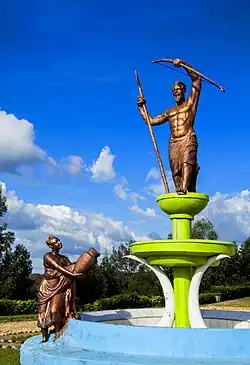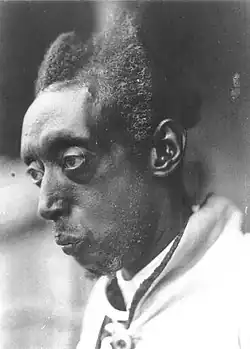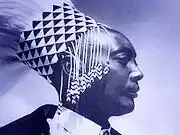List of kings of Rwanda
| Mwami of Rwanda | |
|---|---|
 | |
 | |
| Details | |
| Style | His Majesty |
| First monarch | Gihanga I |
| Last monarch | Kigeli V Ndahindurwa |
| Formation | Unknown (ancient times) |
| Abolition | 28 January 1961 |
| Residence | Nyanza, Rwanda |
| Appointer | Royal Council of Abiru |
| Pretender(s) | Prince Emmanuel Bushayija |
This article contains a list of kings of Rwanda. The Kingdom of Rwanda, historically ruled by sovereigns titled Mwami (plural Abami), was one of the oldest and most centralized kingdoms in Central and East Africa. Its political and spiritual structures were deeply intertwined, with the Mwami serving not only as a temporal ruler but also as a divine intermediary, embodying the principles of kingship, fertility, and cosmic order.
The kingdom’s origins, particularly before the reign of Gihanga I, are enveloped in rich mytho-historical narratives preserved through oral traditions and the indigenous Rwandan philosophical system known as Ubucurabwenge. Gihanga, often described as a cultural hero and founder, introduced foundational elements of Rwandan civilization—including fire, metalworking, cattle domestication, hunting, woodworking, and pottery—while embodying a unique fusion of divine and human authority. Through him and other early deities, such as Mututsi, Kibogo, and Sabizeze (Izeze), the Rwandan people conceptualized governance, cosmology, and morality as inseparable.
Rwandan cosmology, with its intricate pantheon of gods and ancestral spirits, emphasized the immortality of the Ibare (soul) and the cyclical nature of life, death, and renewal. Sacred symbols—such as cows, drums, the moon, and fire—were embedded in ritual practices and coronation ceremonies, reinforcing the Mwami’s role as a living embodiment of divine authority. Female deities and queen mothers were equally venerated, ensuring a balance between male and female forces in guiding the kingdom’s spiritual and societal destiny.
Precolonial Rwanda was thus not only a centralized political entity but also a deeply spiritual and philosophical civilization, where governance, cosmic understanding, and societal wellbeing were inseparable. The kingdom’s enduring legacy lies in its integration of myth, ritual, and pragmatic statecraft—a synthesis that structured Rwandan society for centuries and informed its rich cultural memory.
Kings of Rwanda
After Ibimanuka bya Kabiri: The Abami B'Imishumi
- Gihanga I
- Kanyarwanda I Gahima I
- Rukuge[1]
- Rumeza I
- Yuhi I Musindi
- Rumeza II[2]
- Nyarume[2]
- Rubanda (Lugalbanda)[2]
- Ndahiro I Bamara (Wamala)
14th–20th centuries
| The Abami bibitekerezo: Common era Kings | ||||
| Portrait | Name (Lifespan) |
Reign | Notes | |
|---|---|---|---|---|
| Vansina (2004)[3] | Stewart (2006)[4] | |||
| Ndahiro II Ruyange | – | |||
| Ndahiro III Ndoba | – | |||
| Ndahiro IV Samembe | – | |||
| Nsoro I Samukondo | – | |||
| Nsoro II Byinshi | – | c. 1434–1458 | ||
| Ruganzu I Bwimba | – | c. 1458–1482 | ||
| Cyilima I Rugwe | – | c. 1482–1506 | ||
| Kigeli I Mukobanya | – | c. 1506–1528 | ||
| Mibambwe I Sekarongoro I Mutabazi | – | c. 1528–1552 | ||
| Yuhi II Gahima II | – | c. 1552–1576 | Enumerated as Yuhi I | |
| Ndahiro II Cyamatare | – | c. 1576–1600 | ||

|
Ruganzu II Ndoli | – | c. 1600–1624 | |
| Mutara I Nsoro III Semugeshi | – | c. 1624–1648 | ||
| Kigeli II Nyamuheshera | – | c. 1648–1672 | ||
| Mibambwe II Sekarongoro II Gisanura | c. 1700–1735 | c. 1672–1696 | ||
| Yuhi III Mazimpaka | 1735–1766 | c. 1696–1720 | Enumerated as Yuhi II . | |
| Kalemera Rwaka Ntagara | 1766–1770 | c. 1720–1744 | ||
| Cyilima II Rujugira | 1770–1786 | c. 1744–1768 | ||
| Kigeli III Ndabarasa | 1786–1796 | c. 1768–1792 | ||
| Mibambwe III Mutabazi II Sentabyo | 1796–1801 | c. 1792–1797 | ||
| Yuhi IV Gahindiro | 1801–1845 | c. 1797–1830 | Enumerated as Yuhi III | |
| Mutara II Rwogera (1802–1867) |
1845–1867 | c. 1830–1853 | ||
| Kigeli IV Rwabugiri (1840?–1895) |
1867 – September 1895 | c. 1853–1895 | ||
| Mibambwe IV Rutarindwa | September 1895 – December 1896 | c. 1895 – November 1896 | ||
| 20th century | ||||
| Portrait | Name (Lifespan) |
Reign | Notes | |

|
Yuhi V Musinga[5] (1883–1944) |
December 1896 – 12 November 1931 | ||

|
Mutara III Rudahigwa (1911–1959) |
12 November 1931[6] – 25 July 1959[7] | ||

|
Kigeli V Ndahindurwa (1936–2016[8]) |
28 July 1959[9][10] – 28 January 1961[11] | ||
Timeline (1700–1961)

Pretenders since 1961
.jpg)
On 28 January 1961, in the coup of Gitarama during what was dubbed the Rwandan Revolution by the Belgian-favored Hutu extremist party Parmehutu, the Belgian colonial overseers abolished the monarchy and Rwanda became a republic[11] (retroactively approved by a Hutu led referendum held on 25 September of the same year).[12] Afterwards, Kigeli V Ndahindurwa continued to maintain his claim to the throne until his death on 16 October 2016 in Washington, D.C.[8] On 9 January 2017, the Royal Council of Abiru announced Prince Emmanuel Bushayija as the new heir to the throne. Prince Emmanuel adopted the regnal name Yuhi VI.[13]
See also
- History of Rwanda
- Kingdom of Rwanda
- Ruanda-Urundi
- List of presidents of Rwanda
- Vice President of Rwanda
- Prime Minister of Rwanda
References
- ^ Kagame, Alex. 2015. Inganji Kalinga. New York Publications.
- ^ a b c Leon Delmas
- ^ Vansina, Jan (2004). Antecedents to Modern Rwanda: The Nyiginya Kingdom. University of Wisconsin Press.
- ^ Stewert, John (2006). African States and Rulers (Third ed.). McFarland & Co. p. 190. ISBN 0-7864-2562-8.
- ^ "Olny.nl".
- ^ Frank K. Rusagara (2009). Resilience of a Nation: A History of the Military in Rwanda. Fountain Publishers. p. 99. ISBN 9789970190010.
- ^ Tharcisse Gatwa (2005). The Churches and Ethnic Ideology in the Rwandan Crises, 1900-1994. Regnum Books International. p. 55. ISBN 9781870345248.
- ^ a b "Kigeli V Ndahindurwa, Rwandan king without a crown, dies at 80". The Washington Post. 18 October 2016.
- ^ "A King With No Country". Washingtonian. 27 March 2013.
- ^ Aimable Twagilimana (2007). Historical Dictionary of Rwanda. Scarecrow Press. p. xxix. ISBN 9780810864269.
- ^ a b Leonhard Praeg (2007). The Geometry of Violence. AFRICAN SUN MeDIA. p. 39. ISBN 9781920109752.
- ^ "Kigeli V: Rwandan king with no throne". 9 January 2021.
- ^ Adrian Blomfield (12 January 2017). "Rwanda's new king is former Pepsi salesman residing in Cheshire". the Daily Telegraph. Retrieved 5 April 2017.